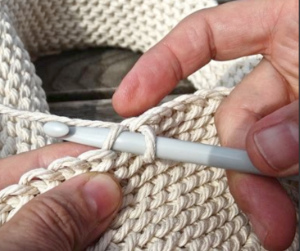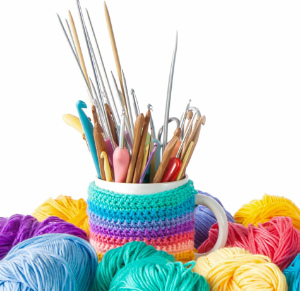 I really love to knit. I got to the point where I was able to knit sweaters, a few with pretty complex patterns, but I spent an awful lot more time ripping out and re-doing my work than I’d care to admit. I just couldn’t seem to get from the intermediate skill level up to the expert level needed to knit complex patterns without a lot of pain.
I really love to knit. I got to the point where I was able to knit sweaters, a few with pretty complex patterns, but I spent an awful lot more time ripping out and re-doing my work than I’d care to admit. I just couldn’t seem to get from the intermediate skill level up to the expert level needed to knit complex patterns without a lot of pain.
A few years back when life got too busy I stopped knitting, and when I recently tried to pick it back up, the results were comically underwhelming. Also, due to my many workaholic years of non-stop typing, my hands have issues now, to the point that a weekend of knitting results in aching hands for the following week.
I’ve missed creating things with yarn, and as I’ve heard that crochet can be a bit easier on the hands, I’ve been thinking of taking that up. When my niece recently contacted me asking for advice on learning to knit or crochet with a group of women in the village where she lives in Alaska, I wrote up the following tips on getting started.
Now I plan to follow my own advice.
Knit vs. Crochet
I worked on writing up an answer to this for a while, then finally gave up and searched for others’ answers. I liked what I saw in this article, so I am lifting text from there and putting it here:
Knitting: One major benefit of knitting is its versatility. It allows for a wide variety of intricate designs such as cables, lacework, and colorwork. This makes it an excellent choice for creating more complex projects like sweaters, scarves, and shawls. However, this also means that it requires a certain level of dexterity and fine motor skills.
Crocheting: One significant advantage of crocheting is that it is generally considered to be simpler than knitting as there are fewer types of stitches to learn. It also usually requires just one hook instead of two needles which can make it easier for people with arthritis who may have difficulty holding multiple objects at once.
And here’s another article comparing the two crafts. The rest of this post focuses on crochet, but much of it can apply also to knitting.
Start with a beginner project
If you are learning this for the first time, start with a simple, small project. A full scarf is fine, but it would take a long time to complete. And if you are a total beginner, the resulting product might not look so great and then you’ll be disappointed. So look for a project that is a simple square, such as a hotpad. (See pattern suggestions in the “Ravelry” section below.) Once you feel comfortable making hotpads, then you can graduate to a scarf, and then maybe can try adding in some new, more complex (and prettier) stitches.
Holding your yarn and tool
 Your experience crocheting (or knitting) will be much better if you spend a little time up front learning the correct way to hold your yarn and crochet hook (or knitting needles). This will make things go more smoothly and if you crochet/knit for many hours at a stretch can save you from cramping your hands. Below are some video results from a fast search… and there are zillions more helpful videos out there!
Your experience crocheting (or knitting) will be much better if you spend a little time up front learning the correct way to hold your yarn and crochet hook (or knitting needles). This will make things go more smoothly and if you crochet/knit for many hours at a stretch can save you from cramping your hands. Below are some video results from a fast search… and there are zillions more helpful videos out there!
- The 3 BEST Ways To Hold Crochet Yarn for Absolute Beginners
- 4 Ways to Hold Your Yarn When Crocheting
- How I Hold My Hook and Yarn
- 3 Ways to Hold Your Yarn in Crochet
Your best friend is Ravelry
 Ravelry (ravelry.com) is the top site where people share patterns and tips for knit and crochet. You definitely will want to get an account (it is free), then you can browse for patterns and more. While most of the patterns cost a bit (not much), there are many free patterns, too. What’s really awesome is that if it is a pattern that others have used, there will usually be comments and photos added from other fiber artists. Also you can submit your questions to others and sometimes the creator of the pattern will answer. I LOVE my Ravelry experience (I am Katemattson there, btw).
Ravelry (ravelry.com) is the top site where people share patterns and tips for knit and crochet. You definitely will want to get an account (it is free), then you can browse for patterns and more. While most of the patterns cost a bit (not much), there are many free patterns, too. What’s really awesome is that if it is a pattern that others have used, there will usually be comments and photos added from other fiber artists. Also you can submit your questions to others and sometimes the creator of the pattern will answer. I LOVE my Ravelry experience (I am Katemattson there, btw).
Here are what look at a fast glance to be good free starter crochet projects on Ravelry:
- Beginner’s Wash Cloth or this Quick Beginner Dish Cloth (Both of these look to be great first projects.)
- Textured dishcloth (This looks like a good second project, or a first project for folks willing to put effort into it.)
- Free and “very easy” crochet patterns (I think most of these are best for a second or third project, maybe not for a first project for a total beginner.)
Whatever pattern you choose, note that using more than one color really is not appropriate for a first project—save that for a second (or third) project on your learning journey.
YouTube is another of your good friends
 I recently did some knitting after a several-year break and found I’d forgotten a few key things. So I just went to YouTube, typed the stitch I needed to re-learn, and there was the help I needed; although sometimes I needed to slow the playback speed to figure it out. Below are a few suggested channels to get you started on crochet tips. [Caveat: I did not WATCH any of these, but judged them by the view counts and thumb-ups.]
I recently did some knitting after a several-year break and found I’d forgotten a few key things. So I just went to YouTube, typed the stitch I needed to re-learn, and there was the help I needed; although sometimes I needed to slow the playback speed to figure it out. Below are a few suggested channels to get you started on crochet tips. [Caveat: I did not WATCH any of these, but judged them by the view counts and thumb-ups.]
- 25 Crochet Hacks for Beginners
- Crochet Straight Edges in 1 Minute (I like this, because crooked edges are a common rookie mistake in both knit and crochet that really affects how the finished piece will look.)
- How to Crochet for Absolute Beginners: Part One—Bella Coco channel (See the description on the video for links to the other parts of the video)
- How to Crochet for Absolute Beginners: Part 1—SimplyDaisy channel (See the description on the video for links to the other parts of the video)
Of course, there are many more videos out there—once you start looking you’ll find many options.
 Supplies
Supplies
Finally, you’ll need to get your crochet hooks (or knitting needles) and yarn.
Back when I was a regular knitter I went to my local knitting shop for all that, but it closed during the sad Covid days: Farewell to the wonderful Knitting Bee! So I need to find a new resource.
I have a pretty huge stash of yarn, but now that I’m looking to get into crochet, I’ll need to get new tools. I plan to start with the WEBS yarn store—but honestly, there are many other options. If you live in a large enough town, there may be a local shop where you’ll find not only the supplies you need, but staff who can advise you. And if you’re lucky, this place will also have crafting nights and other options that will help you launch into this hobby.
And here’s what looks to be a good article about crochet hook sizes.